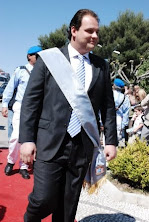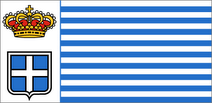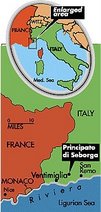
H.R.H. Prince George I, at 70 years of age and after 43 years of uninterrupted reign, has announced his abdication. It will be the task of the population of the small Principality to name its successor, by election and conducted in complete autonomy, as it happened in 1963 when the Prince was crowned for life with a plebiscite (from the 362 citizens).
In the sixty days of "vacant post" the eight ministers will continue to govern, together with the 24 Priori that form the Parliament.
The Prince's decision is irrevocable and was announced during a function in occasion of the Festivity of Saint Sebastian (20 January). The official explanation of this decision is because "there is need for renewal and the throne needs of new energy".
But behind the official explanation of this surprising event is a clash with the Mayor of Seborga, Franco Fogliarini, accused by the Prince of “not respecting the history of Seborga”.
In the sixty days of "vacant post" the eight ministers will continue to govern, together with the 24 Priori that form the Parliament.
The Prince's decision is irrevocable and was announced during a function in occasion of the Festivity of Saint Sebastian (20 January). The official explanation of this decision is because "there is need for renewal and the throne needs of new energy".
But behind the official explanation of this surprising event is a clash with the Mayor of Seborga, Franco Fogliarini, accused by the Prince of “not respecting the history of Seborga”.
The quarrel is in regard to the project of upgrading the area in front the ancient Cistercians Church of Saint Bernardo, a precious monument of 1258, than one legend says has guarded one sacred relic. The planners want to put modern paving around the Church while H.R.H. George I is of the opinion that the area should respect and reflect the architecture and the age of the place when - as the English historians wrote - "Seborga became the first constitutional monarchy of the world ".
"It is my strong wish to defend and preserve our history and our traditions, but, in my capacity as Prince, I cannot start a "war" with the Italian authority represented here by the Mayor", says George I. Some people in Seborga believe that this action from the Prince is just a provocation, an expedient to attract the attention of the public on this matter of grave concern for the Prince.
"It is my strong wish to defend and preserve our history and our traditions, but, in my capacity as Prince, I cannot start a "war" with the Italian authority represented here by the Mayor", says George I. Some people in Seborga believe that this action from the Prince is just a provocation, an expedient to attract the attention of the public on this matter of grave concern for the Prince.
The question now is if the future successor will be able to continue to maintain the unique characteristics of the place and fulfil the plans of its predecessor. One thing is sure: George I has put Seborga on the world map and raised attention from all over the world. Despite there are being no hotels in Seborga, buses of tourists come everyday to Seborga, from all Europe, keeping all the local restaurants busy.
The origin of Seborga goes back to Centuries. Born as Castrum Sepulcri, Seborga was considered a sacred place for the Catars and still today has maintained a rebellious spirit. Later it become a feud of Conti di Ventimiglia and was consecrated in 1079, as Principality of the Sacred Roman Empire. In 1118 it was transformed in state Cistercians and it remained so until 1729 when it was purchased from Vittorio Amedeo. Many experts and historians from all Europe have been consulted about the validity of the status of the Principality.
H.R.H. George I never tires of repeating and declaring that "the Principato has never been entered as part of the Reign of Italy and – therefore - of the Italian Republic ", and his declaration has the support of many historians and the Catholic Church.
The German historian Wolfgang Schippke wrote in his book "The Mountain Roads of the Ligurian Coast" (Strade di montagna della costa ligure): "Benito Mussolini, in a document dated 1934 recently found in the Berlin archives, declared that "for sure the Principato di Seborga does not belong to Italy" ".
Meanwhile, since 1963 the Principality mints its currency, issuess stamps, number plates for the cars of its residents, guards its borders and maintains regular diplomatic relations with 45 States, including Europe.
The Seborga Times will keep you posted for new developments on the matter.
The origin of Seborga goes back to Centuries. Born as Castrum Sepulcri, Seborga was considered a sacred place for the Catars and still today has maintained a rebellious spirit. Later it become a feud of Conti di Ventimiglia and was consecrated in 1079, as Principality of the Sacred Roman Empire. In 1118 it was transformed in state Cistercians and it remained so until 1729 when it was purchased from Vittorio Amedeo. Many experts and historians from all Europe have been consulted about the validity of the status of the Principality.
H.R.H. George I never tires of repeating and declaring that "the Principato has never been entered as part of the Reign of Italy and – therefore - of the Italian Republic ", and his declaration has the support of many historians and the Catholic Church.
The German historian Wolfgang Schippke wrote in his book "The Mountain Roads of the Ligurian Coast" (Strade di montagna della costa ligure): "Benito Mussolini, in a document dated 1934 recently found in the Berlin archives, declared that "for sure the Principato di Seborga does not belong to Italy" ".
Meanwhile, since 1963 the Principality mints its currency, issuess stamps, number plates for the cars of its residents, guards its borders and maintains regular diplomatic relations with 45 States, including Europe.
The Seborga Times will keep you posted for new developments on the matter.



